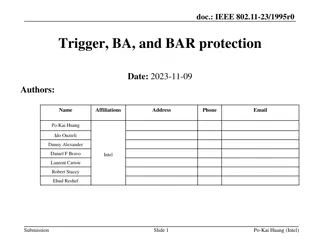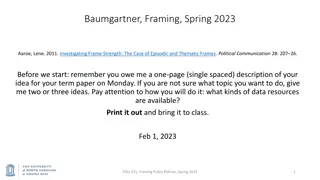Inertial and Non-Inertial Frames of Reference
Frames of reference play a crucial role in describing and observing motion. In physics, there are two main types of frames of reference: inertial and non-inertial. An inertial frame is one that moves at a constant velocity, where Newton's first law holds true. Such frames have specific characteristics that are essential in understanding motion and forces. In contrast, non-inertial frames are accelerating and involve fictitious forces. By comprehending the concepts of inertia and frames of reference, we can analyze motion accurately and predict the behavior of objects in different scenarios.
Download Presentation

Please find below an Image/Link to download the presentation.
The content on the website is provided AS IS for your information and personal use only. It may not be sold, licensed, or shared on other websites without obtaining consent from the author.If you encounter any issues during the download, it is possible that the publisher has removed the file from their server.
You are allowed to download the files provided on this website for personal or commercial use, subject to the condition that they are used lawfully. All files are the property of their respective owners.
The content on the website is provided AS IS for your information and personal use only. It may not be sold, licensed, or shared on other websites without obtaining consent from the author.
E N D
Presentation Transcript
Frames Of Reference Frame of reference: A coordinate system relative to which motion is described or observed. It consists of an abstract coordinate system and set of physical reference points that uniquely fix the coordinate system and standardize the measurements within that frame. We can use frame of reference to see how fast something appears to move from different perspectives.
Types Of Frame Of Reference There are two types of frames of reference: Inertial frame of reference Non-Inertial frame of reference
First of all we have to know about Inertia Inertia is a property of matter by which it continues in its existing state of rest or uniform motion in a straight line, unless that state is changed by an external force. A tendency to do nothing or to remain unchanged.
Inertial Frames Of Reference: Definition: A frame of reference that moves at a zero or constant velocity. A frame in which Newton s first law holds true. According to Newton s law, a body not acted upon by any external force, has an unaccelerated motion(i.e., if no external force acts on a body, its acceleration remains zero). In other words, if the body is at rest, it remains at rest, but if it is in motion, it remains moving with the same speed in the same direction, unless the external force is applied.
Several ways to describe an inertial frames. Here are few descriptions: An inertial frame of reference is a frame of reference with constant velocity. An inertial frame of reference is a non-accelerating frame of reference. An inertial frame of reference is a frame of reference in which law of inertia holds. An inertial frame of reference is a frame of reference in which Newton s law of motion hold. In an inertial frame of reference no fictitious forces arise.
Example 1 Consider two frames S and S either stationary relative to each other or moving with a constant velocity relative to each other. A body which is stationary to an observer in a frame S, will either appear to be stationary or will appear to be moving with constant velocity to an observer in the frame S also, i.e., the force acting on the body for the observers of both frames will be zero. Similarly, if a body is moving with some acceleration a relative to the observer in the frame S, the body will have the same acceleration relative to the observer in the frame S .
Example 2 A book lying on the table is stationary. It will be at rest as long as no external force acts on it.
Example 3 A train is moving with constant velocity.It will move with constant velocity as long as it is acted upon by external force.
Non-Inertial Frame Of Reference A frame of reference that accelerates with respect to an inertial frame of reference. The first Newton s law does not hold. Non- inertial frames of reference occur inside the objects which are accelerating. Non- inertial frame of reference have fictitious forces which act upon objects in the reference frames.
Fictitious Force It is an apparent yet non-existent force invented to explain the movement of objects within non inertial frames of reference.
Examples An accelerating car pushes us back into seat. We enjoy a roller coaster or a ride at the midway precisely because they are not inertial frame of reference.


























